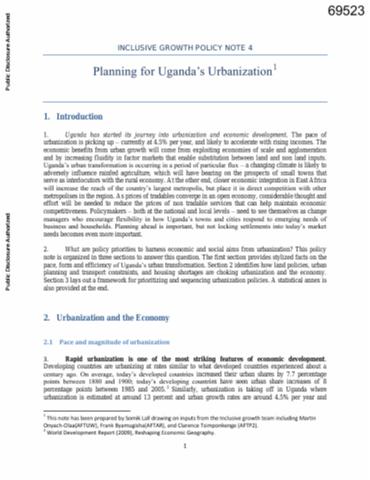Resource information
Uganda has started its journey into urbanization and economic development. The pace of urbanization is picking up currently at 4.5 percent per year, and likely to accelerate with rising incomes. The economic benefits from urban growth will come from exploiting economies of scale and agglomeration and by increasing fluidity in factor markets that enable substitution between land and non land inputs. Uganda's urban transformation is occurring in a period of particular flux a changing climate is likely to adversely influence rain fed agriculture, which will have bearing on the prospects of small towns that serve as interlocutors with the rural economy. At the other end, closer economic integration in East Africa will increase the reach of the country's largest metropolis, but place it in direct competition with other metropolises in the region. As prices of tradable converge in an open economy, considerable thought and effort will be needed to reduce the prices of non tradable services that can help maintain economic competitiveness. Policymakers both at the national and local levels need to see themselves as change managers who encourage flexibility in how Uganda's towns and cities respond to emerging needs of business and households. Planning ahead is important, but not locking settlements into today's market needs becomes even more important. What are policy priorities to harness economic and social aims from urbanization? This policy note is organized in three sections to answer this question. The first section provides stylized facts on the pace, form and efficiency of Uganda's urban transformation. Section two identifies how land policies, urban planning and transport constraints, and housing shortages are choking urbanization and the economy. Section three lays out a framework for prioritizing and sequencing urbanization policies. A statistical annex is also provided at the end.


